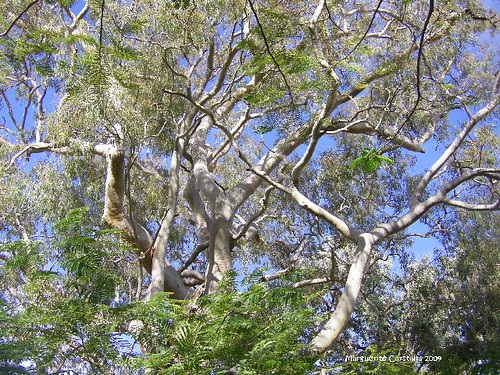Beautiful Trees line the shore.
They are a haven for the many birds that live here, provide shade and are very beautiful.
http://asgap.org.au/eucal1a.html
Gum trees (eucalypts) are the essence of the Australian flora. Their range extends from sub-alpine areas to wet coastal forests, temperate woodlands and the arid inland. In fact, the only major environment where eucalypts are absent is probably rainforest. There are about 12 species which occur naturally outside of Australia but around 700 are Australian endemics. Only 2 species are not found in Australia. One of these, Eucalyptus deglupta, is the only eucalypt to be found growing naturally in the northern hemisphere, occurring in the southern Phillipines (as well as in New Guinea and parts of Indonesia).
Even Australians who wouldn't know a Banksia from a Begonia know what a gum tree looks like and smells like. Soldiers returning by ship from the first and second world wars are rumoured to have been able to smell the aroma of the eucalypt before land was visible on the horizon. Most Australians may not be able to identify a particular species (there are hundreds of them, after all!) but they will know "that's a eucalypt".
Although usually regarded as applying to the genus Eucalyptus, the term "eucalypt" really encompasses the closely related genera Angophora and Corymbia as well. Corymbia is, in fact, a new genus (1995) which contains 113 species, 80 of which were formerly within Eucalyptus. Angophora consists of about 13 species.
The term "gum tree" is derived from the habit of some eucalypt species to exude a sticky, gum-like substance from the trunk. This is by no means a general characteristic but "gum tree" has become a common generic term for most eucalypts. A number of other common names have been applied to certain groups of eucalypts based on features such as bark type, timber characteristics or growth habit. Some names in common usage are:
* Apple - A name used by early European settlers due to a similarity in appearance of some plants to apple trees (eg. Angophora bakeri, "Narrow-leaved apple")
* Ash - Timber is similar to the European ash trees (eg. Eucalyptus regnans, "Mountain ash")
* Blackbutt - The lower part of the trunk has persistent bark which is usually black due to past fires (eg. Eucalyptus pilularis, "Blackbutt")
* Bloodwood - Timber often has pockets of a dark red gum known as kino (eg. Corymbia eximia, "Yellow bloodwood")
* Box - Bark is retained on the tree and is short fibred; plates of bark may shear off with age (eg. Eucalyptus melliodora ("Yellow box")
* Ironbark - Bark is retained on the tree and is hard and deeply furrowed (eg. Eucalyptus crebra, "Narrow-leaved ironbark")
* Mallee - Multi-stemmed trees, usually fairly small in height (eg. Eucalyptus albida, "White-leaved mallee")
* Peppermint - The oil in the leaves has a peppermint-like aroma (eg. Eucalyptus dives, "Broad-leaved peppermint")
* Ribbon Gum - Bark is deciduous and is shed in long strips which often hang from the branches (eg. Eucalyptus viminalis, "Ribbon gum")
* Scribbly Gum - Bark is deciduous and the smooth trunk is marked with "scribbles" caused by an insect larva (eg. Eucalyptus sclerophylla, "Scribbly gum")
* Stringybark - Bark is retained in long fibres which can be pulled off in "strings" (eg. Eucalyptus eugenioides, "Thin-leaved stringybark")
Photographs and Art from Places on the Coast of East Australia. Gold Coast, Stradbroke Island, Burrum Heads, Hervey Bay and surrounding coastal areas
Thursday, November 12, 2009
Eucalyptus Tree
Subscribe to:
Post Comments (Atom)

140x45.jpg)




No comments:
Post a Comment